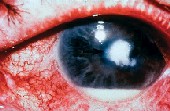Researchers in two locationsthe L.V. Prasad Eye Institute (LVPEI) in Hyderabad, India, and the Cornea and Contact Lens Research Unit (CCLRU) in Sydney, Australiaenrolled a total of 957 adult lens wearers. All participants wore low-Dk/t disposable soft contact lenses in one or both eyes on a six-night wear and replacement schedule for up to 12 years. None had any history of ocular or systemic issues or usage of any drugs that may have affected contact lens wear.
Results showed six cases of microbial keratitis, which equates to an estimated 57.9 occurrences of MK per 10,000 eyes per year of lens wear, or one in 173 wearers per year of lens wear.
For more than 10 years, population-based studies of the annual incidence of MK due to extended wear of soft lenses have remained relatively unchanged. Incidence has been reported at 9.3 cases per 10,000 wearers in Hong Kong, 20 cases per 10,000 wearers in the Netherlands and 20.9 cases per 10,000 wearers in the United States, the study says.
 |
| Microbial keratitis due to contact lens wear. |
Previous studies have shown that more adverse effects are seen in soft contact lens wearers in India than elsewhere, due to greater microbial and other contaminants found in the country.
LVPEI had more male participants than CCLRU, and the male gender is an established risk factor for MK. While this finding has only been documented in daily-wear users, a higher number of male cases at LVPEI may have affected the outcome at this location, the researchers say.
Microbial keratitis is the only potential serious complication with contact lenses, and this study emphasizes the need for continual vigilance on the part of the practitioner, especially with regard to the need to be as proactive as possible with patients on hygiene and on the importance of getting immediate attention for any persistent pain or redness, says Brien A. Holden, Ph.D., one of the researchers at CCLRU. A wearer who leaves a lens in a Pseudomonas-infected eye for five days runs an unfortunately high chance of losing some vision.
1. Holden BA, Sankaridurg PR, Sweeney DF, et al. Microbial keratitis in prospective studies of extended wear with disposable hydrogel contact lenses. Cornea 2005 Mar;24(2):156-61.
|
Silicone Hydrogels Are Five Times Safer for Sleeping Morgan PB, Efron N, Hill EA, et al. Incidence of keratitis of varying severity among contact lens wearers. Br J Ophthalmol 2005 Apr;89(4):430-6. |

